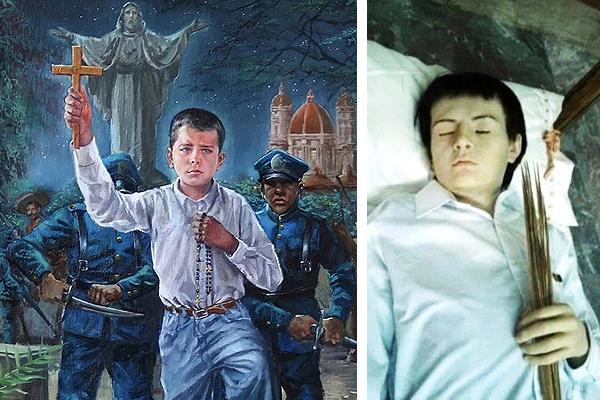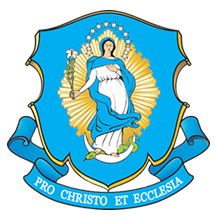
The brave 14-year-old for Christ: St. José Sánchez del Rio. A wax effigy is at right.
Welcome to "North American Sanctity," a new series on holy men and women, boys and girls, saints and those on the road to sainthood, from Canada, the United States, and Mexico. Some will be familiar, others less so; but all are inspiring!
By Kimberly Bruce
“If you shout, ‘Death to Christ the King,’ we will spare your life.” But José answered, “¡Viva Cristo Rey! Long live Christ the King! Long live the Virgin of Guadalupe!”
Faced with this choice, what would you do? That’s the situation 14-year-old St. José Sánchez del Rio (feast day Feb. 10) found himself in, in 1920s Mexico.
Martyred for his refusal to deny Christ, St. José was a member of the Cristeros, a group of landowners, ranchers, and sharecroppers who revolted against the anti-Catholic government of Mexico in 1926. The Mexican government had implemented laws intended to marginalize and eliminate the Catholic Church from the lives of its people. The Cristero War lasted until 1929, though Cristeros were hunted and persecuted well into the 1950s.
His life
Saint José’s parents were cattle ranchers who lived in Sahuayo, Michoacán, Mexico, about 300 miles west of Mexico City. They raised their four children with great devotion to the Catholic faith.
José was third in the lineup of their children, born on March 28, 1913. Even as a young boy, little St. José said his Rosary daily, attended Holy Hours with the Blessed Sacrament, and encouraged other children in the faith.
Only 12 years old when the Cristero War broke out, José pleaded with his mother to be allowed to join his two older brothers in the Cristeros. She objected strongly to his pleas, but young José responded, “Mama, do not let me lose the opportunity to gain Heaven so easily and so soon.”
Commander Prudencio Mendoza of the Cristeros did not want young José to join the ranks, either. He said to José, “What contribution can so small a boy make to our army?”
José answered, “I ride well. I know how to tend horses, clean weapons and spurs, and how to fry beans and tortillas.”
Mendoza relented, allowing José to be the flagbearer for the troop. In this position, José received the nickname "Tarcisius," in reference to an early Christian martyr who died protecting the Eucharist. Mendoza soon promoted him to be an aide of General Rubén Guízar Morfin. The General promoted him to bugler, and it became José’s job to ride with the general into combat and deliver his orders via the bugle.
A fateful battle
During heavy combat on Feb. 6, 1928, General Morfin’s horse was shot by the opposing force. Fourteen-year-old José jumped off his horse and shouted, “General! Take my mount and escape to safety. You are of far greater importance to the Cristero cause than I am.” He helped the general atop the horse and slapped the horse’s rear, sending the horse and general on their way.
Shooting from behind a rock until he was out of ammunition, José was eventually captured by federal soldiers, who shackled him in irons and imprisoned him.
During captivity, José wrote to his mother telling her he was ready to suffer for Christ. He was filled with trust in our Lord — a trust that St. Faustina, too, exemplified, as expressed in her Diary:
O my Jesus, despite the deep night that is all around me and the dark clouds which hide the horizon, I know that the sun never goes out. O Lord, though I cannot comprehend You and do not understand Your ways, I nonetheless trust in Your mercy. If it is Your will, Lord, that I live always in such darkness, may You be blessed. I ask You only one thing, Jesus: do not allow me to offend You in any way. O my Jesus, You alone know the longings and the sufferings of my heart. I am glad I can suffer for You, however little. When I feel that the suffering is more than I can bear, I take refuge in the Lord in the Blessed Sacrament, and I speak to Him with profound silence (Diary of Saint Maria Faustina Kowalska, 73)
True to the end
Willing to suffer for Christ like St. Faustina, José stood firm in faith and trust. The soldiers forced him to watch as they tortured another Cristero. Instead of allowing this to frighten him, José encouraged his comrade, saying, “You will be [in] Heaven before me. Prepare a place for me. Tell Christ the King I shall be with him soon.”
Angered even more, the soldiers cut the skin off the bottoms of José’s feet and made him walk on salt. Screaming in pain, José did not give in to their demands to shout “Death to Christ the King!” to save his life. On Feb. 10, 1928, he was cut with a machete and shot several times at point-blank range until he died.
Proclaimed one of the Church’s most recent saints, young José was beatified by Pope Benedict XVI in 2005 and canonized by Pope Francis in 2016. He is buried above a side altar in the Church of Saint James the Apostle in Sahuayo, his hometown.
Saint José is one of the characters in the 2012 film For Greater Glory: The True Story of Cristiada, which depicts the story of the Cristero War and José's martyrdom.
Learn from St. José
When you suffer, and when you see no way out of your troubles, do you turn to God? Go visit Him in church before the Blessed Sacrament, as little St. José and St. Faustina did. Trust His mercy and His plan for your life and want nothing more than to please Him by your actions.
Offer up your sufferings for others, in the meantime, while waiting for answers to your prayers. Be at peace, knowing that the God of all Mercies desires only the good for you, your family, and your soul.
Little St. José Sánchez del Rio, pray for us!
¡Viva Cristo Rey!
Next in the series: Blessed Sebastian de Aparicio, Feb. 25.
{shopmercy-ad}
















